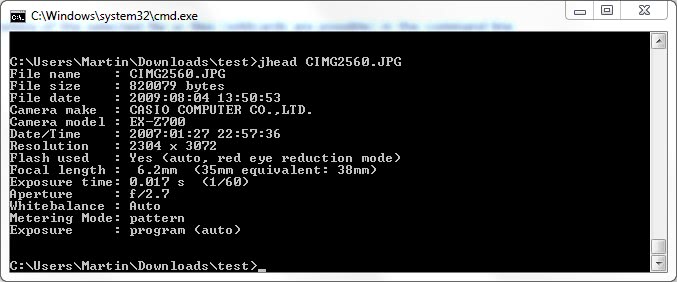Exif Metadata Editor Jhead

Jhead, which stands for JPEG header manipulation tool, is a free program for Windows, Mac and Linux that enables you to edit image Exif metadata information.
So called exif metadata - or exif data - is automatically added to photos that are captured by digital cameras.Exif stands for Exchangeable image file format; it defines formats used by digital cameras.
Note that this functionality is not restricted to camera-only devices, but also included in devices such as smartphones or tablets with camera functionality.
The data that is added to the photo depends largely on the digital camera, but it usually includes information such as the time and date the photo was taken, the camera model, resolution and other technical information.
It may also contain preview thumbnails of the photos in the header or location information. The information contained in the exif header can pose a privacy risk. Think of cutting an image but keeping the exif data of the original image. The thumbnail image could show more of a photo than desired.
Tip: We have published a guide that explains how to find out which Exif data your digital cameras save automatically.
Jhead JPEG header manipulation tool
Exif data mayn also contain comments and other information that many users might not want attached to images that they publish on the Internet.
Jhead is a command line application that can display the content of the exif file for one or multiple jpeg images.
More powerful than revealing the content of exif data is the use as an exif metadata editor. Jhead can edit, add and remove data from selected jpeg photos easily.
The huge list of commands is available on the developer's website. It ranges from replacing exif data with data from another photo, manipulating date, time, thumbnails and general data.
The default command jhead filename will output the exif metadata of the selected file or files (wildcards are possible, e.g. jhead *.jpg) on the command line. You may redirect the output to a file using the > filename option, e.g. jhead *.jpg > c:\test\output.txt.
Commands that you may find interesting include:
- -dc to delet the comment field from the header.
- -de to delete the entire Exif header.
- -di to delete the IPTC section.
- -dx to delete the XMP section.
- -du to delete any sections that Jhead does not know about.
- -purejpg to delete all JPEG sections but the ones required to render the image. Strips any metadata from the image (by using -de, -dc- and -du options.
- -dt to delete thumbnails from the Exif header.
You may run these operations on a folder, or individual images. The command jhead -purejpg -dt c:\users\martin\pictures\holiday\*.jpg would run the commands on all jpg images stored in the selected folder.
Jhead is available for Microsoft Windows, Mac Os X and Linux operating systems. It can be downloaded from the developer's website.




























is there any commandline tool which can add title, desc, author, etc.? jhead or exif tool can’t do that.
If you’re looking for tools to manipulate photo metadata, you also might be interested in ExifTool by Phil Harvey (http://www.sno.phy.queensu.ca/~phil/exiftool/). The advantage to his tool is that it has been around long enough that other tools have been build on top of it, like the ExifToolGUI for Windows (http://freeweb.siol.net/hrastni3/foto/exif/exiftoolgui.htm).